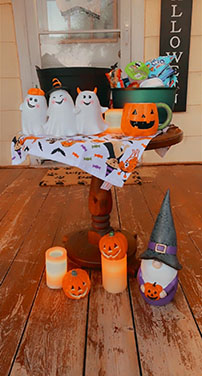By Caitlin Hofen, Feature Editor
Monday is Halloween, marked by bright costumes, scary movies, and candy galore.
However, the origin of Halloween dates to ancient times and the Celtic festival of Samhain.
Samhain (pronounced “SAH-win”) celebrated the end of harvest and ushered in the “darker half of the year,” according to history.com.
The people who celebrated Samhain believed the barrier between the physical and spiritual world broke from Oct. 31 to Nov. 1, allowing ghosts and monsters to walk among the living.
The origins of many modern Halloween traditions tie back to the festival of Samhain.
COSTUMES
While princesses, ninjas and superheroes haunt the streets today on Halloween night, the tradition of dressing up started for protection.
Since the Celts believed the barrier between worlds could be broken, they prepared offerings for the fairies, or Sidhs.
This helped prevent the fairies from wreaking havoc. It was also expected that ancestors could cross over, too.
The Celts would dress as animals or monsters to scare the fairies and discourage them from taking their loved ones back to the other world, history.com said.
Celtic mythology describes monsters like the Lady Gwyn, a headless woman dressed in white who is accompanied by a black pig. She chased people who wandered around at night.
Another monster associated with Samhain is a shape-shifting creature called a Pukah, who receives harvest offerings from the field.
JACK-O’-LANTERNS
In the Middle Ages, the Celts in Ireland began the practice of carving jack-o’-lanterns.
Large turnips and potatoes served as the original canvases, according to history.com.
The practice started from an Irish myth about a man nicknamed “Stingy Jack.”
The story goes that Stingy Jack invited the Devil to have a drink with him, but he didn’t want to pay.
He convinced the Devil to turn into a coin Jack could use to pay their bill.
Once the Devil changed forms, Jack slipped the coin into his pocket next to a silver cross, preventing the Devil from changing back.
The story continues, describing ways Jack would free the Devil and coerce it into not bothering him again for a number of years.
It also agreed to not claim Jack’s soul once he died.
When Jack finally died, the story says God would not allow such a person into heaven and the Devil was still upset about being tricked, so it didn’t banish him to hell.
Instead, the Devil sent Jack off into the night with a burning coal to light the path.
Jack put the coal into a carved-out turnip and has been roaming the Earth since.

The ghostly figure of Jack became known as “Jack of the Lantern,” then shortened to “Jack O’Lantern.
People started making their own versions of jack-o’-lanterns to ward off the spirit of Stingy Jack.
When immigrants brought the tradition to America, the pumpkin was found to make the perfect jack-o’-lantern.
TRICK-OR-TREATING
Every Halloween, children run door to door, ringing doorbells and calling out “trick or treat.”
The origin of this tradition started in the 9th century, when Christianity started to spread and combine with pagan practices.
The Catholic Church named Nov. 2 as All Souls’ Day, a time to honor and pray for the dead.
Poor people would visit the rich and offer their prayers for the dead family of the rich person in exchange for a dessert called a soul cake.
In Scotland and Ireland, young people took part in a tradition called guising, dressing up in costume and accepting gifts from many households, said history.com. Instead of offering to pray for the dead, they would sing a song, recite a poem, tell a joke or perform another sort of “trick” before collecting their treat.

